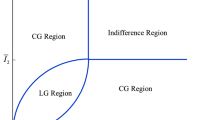Abstract.
During the November 1988 election cycle, the residents of Mississippi's 82 counties were allowed to choose whether or not to switch to an alternative system for governing the construction and repair of county roads. Under the system then used statewide – the so-called beat system – each of a county's five elected supervisors determined spending priorities and allocated funds within the boundaries of his or her own district. Under the alternative system – the so-called unit system – such choices were to be made by the supervisors collectively and then executed by a hired professional road manager. This paper models the decision of voters to retain the beat system (38 counties) or to switch to the unit system (44 counties). Theory and evidence suggest that the choice between centralized versus decentralized governance depends on the perceived costs and benefits of the alternatives to voters and their elected representatives.
Similar content being viewed by others
Author information
Authors and Affiliations
Additional information
Received: February 24, 2000; Accepted: September 20, 2001
Rights and permissions
About this article
Cite this article
Karahan, G., Razzolini, L. & Shughart II, W. Centralized versus decentralized decision-making in a county government setting. Econ Gov 3, 101–115 (2002). https://doi.org/10.1007/s101010100038
Issue Date:
DOI: https://doi.org/10.1007/s101010100038




